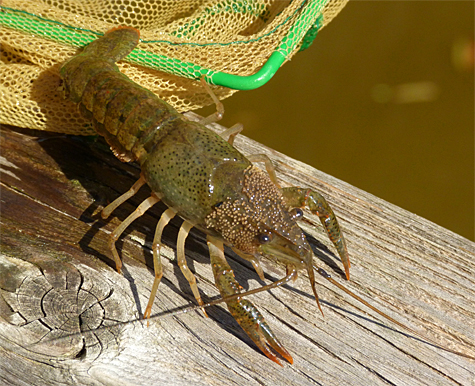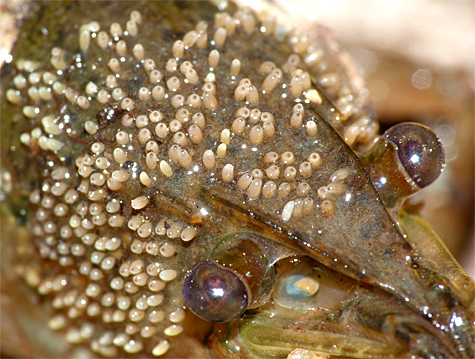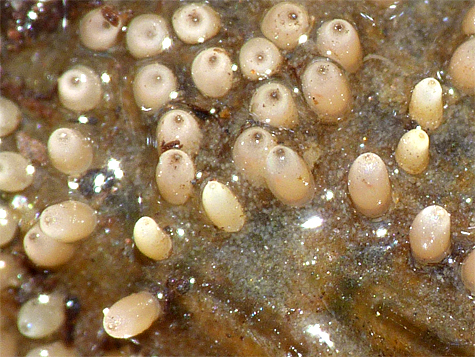During a Wetlands program for a school group last week, Master Teacher Courtney captured a crayfish which had strange growths on its head. Immediately upon seeing the crustacean, I suspected mites. I took a few photos of the crayfish and at the end of the program the decapod was released into the water along with all the other specimens used for the program. That was that, or so I thought.

I became skeptical of the mites explanation after looking at the photos. Most mites that I’ve seen are a different shape, rounded, not oblong like the projections on the head of the crayfish. Unfortunately, I didn’t take close up photos so I couldn’t get a clear, close look at them.
The following day, another school group and another program given, this time, by Teachers Meredith and Adrienne. The same crayfish was captured, or one just like it, tiny projections and all. This time however, I was convinced that they were some kind of aquatic insect eggs on the crayfish, not mites. I took more photos.

After doing some searching on the web I found two sources that would help me figure out what those little eggs were, if they were eggs at all.
In a book titled “Aquatic Insects of California,” University of California Press, I found the following:
“…An interesting ovipositor relationship between a corixid [water boatman] and a crayfish was first noted by Forbes (1878). According to Griffith (1945) the eggs of Ramphocorixa acuminata [a species of water boatman] are preferably deposited upon crayfish…”
Searching further I came upon this from “The Universtiy of Kansas Science Bulletin,” Vol. 11-12, University of Kansas:
“No waters appear to be too stagnant for its abode [talking about Ramphocorixa acuminata], which may account for its strange habit of placing its eggs upon the carapace of crayfish…”
Both of those studies are referring to animals in California or some location west of the Mississippi. The reference below is a little closer to home:
“Epibionts of pond-reared adult Malaysian prawns, Macrobrachium rosenbergii (de Man), in South Carolina,” Marine Resources Research Institute, Charleston, SC
“Eggs of the water boatman, Ramphocorixa acuminata, were observed on 52.5% of the females (mean size, 78.0 g) and 5.9% of the males at harvest. Egg deposition was limited to the cephalothorax [head] and/or the first and/or second abdominal segments.”
Here, though, they’re talking about Malaysian Prawns, not crayfish. It does, however, indicate that the water boatman in question lives in our area and is depositing eggs on crustaceans.

I kept the crayfish in a small tank in my office over the weekend to see if the eggs would hatch. The eggs didn’t hatch, but the crayfish is now in the large aquarium in the Insectarium of the Butterfly House. Water Boatman, Backswimmers, and other aquatic insects are kept in the aquarium for visitors to look at when they tour the facility.
To stock the aquarium, Butterfly House staff have to capture its residents themselves or purchase them elsewhere, from a biological supply for example. If the eggs on the crayfish are indeed water boatman, which seems fair to assume, there will soon be a few hundred additions to the tank, free of charge. And, we will find out for certain if they are indeed water boatman.
Coming Soon:
Part II of “The Crayfish Among Us.”
You really don’t want to miss Part II.
Yay! That’s awesome and I’m glad A and Mer caught another one- I hadn’t thought to keep it in the insectarium to find out what they would finally be! Looking forward to finding out the results 🙂
I’ll be checking the crayfish daily, twice a day, so I’ll let you know if and when the eggs hatch.
And yes, I do think a different crayfish was caught the next day. If you look at the top picture at left you’ll notice that two tail fan sections (uropods) are missing on the crayfish that you caught on the first day of the programs. The crayfish captured the next day (the one that now resides in the Insectarium aquarium) has those uropods intact.
Thanks,